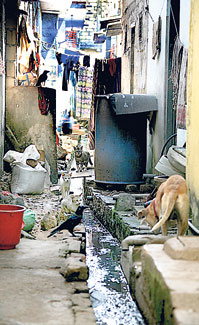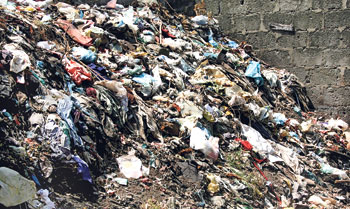Two children are dead – a girl and a boy, both about eight years old, both living in the same area and both attending the same school. What went wrong in the Modera-Mattakkuliya area that two children had to die in the first month of 2009, soon after they went into a new class but long before they could thumb through their new books or wear the new clothes their parents had bought for them?
Dengue was the killer and if the Colombo Municipal Council area is taken under the microscope, the findings are shocking. More than 100 cases of dengue have been reported in just one month (January 2009) from this area, supposed to be the showpiece Municipal Council of the capital city of the country, with 48 cases, including two deaths, being reported from Modera-Mattakkuliya alone.
 |
| Stagnant water in drains. All this from an area, supposed to be the showpiece of the CMC. |
Why is it that Sri Lanka cannot cope with diseases such as dengue which rise like a spectre every year is the burning question that keeps coming up as The Sunday Times team tours Modera-Mattakkuliya, talking to men, women and children, including the parents of the little boy who is dead.
“My second boy was ill with dengue and received treatment at the Lady Ridgeway Hospital. Then my eldest son got fever, I took him to the doctor and in four days he was okay. But on the fourth day though there was no fever, he got a stomach ache and his body turned cold. We rushed him to LRH where they did everything possible,” says mother Jothy Ilango, sighing that he would have been eight years old in October. Her third son was also at the LRH with fever.
From the people of the area, the complaints are many, foremost being the non-collection and non-clearance of garbage and also non-cleaning of the drain network – against the Municipality and more mildly against each other in the community. This has been going on for years, is a common grouse, echoed and re-echoed with stoic resignation.
The Municipality hardly ever comes to clean the drains, which are full of stagnant water. When we do complain, after a long time they send a backhoe which is not the right equipment. It digs too deep and breaks the concrete flooring of the drain as also the top edges, keeping puddles in the drain for mosquito infestation even when we on our own clean the muck, said a furious woman who on her own has organized many shramadana campaigns.
There is wry humour among the knot of people as they recall how the kunu karaththe (garbage cart) comes round at 7.30 every morning. “It is very regular. The man collects the stinking garbage and awaits the truck at a pre-decided meeting point. But the truck never comes. So he dumps the garbage somewhere, and everyday the heap gets higher and higher, the stench worsens, polythene is strewn around, stray animals spread the garbage,” said another woman, adding ‘katha karala wedak ne’ (There’s no point in talking).
Another man alleged that when the muck is pulled out of the drains, it is heaped up on the edges and it is days or never, before the garbage truck comes to pick up the filth.
Sunday, February 1, was another example of the inefficiency and incompetence of the Colombo MC, said another woman. Sarvodaya had mobilized the community, along with the support of the MC to carry out a major shramadana campaign in view of the spread of dengue in the area.
“Everyone got onto the road. The clean-up was a success, but the muck was not removed by the MC for three days,” lamented a mother of two children, explaining that palwechcha mada, ganda gagaha, virus bo kara kara geval laga thibba. (The rotting soil giving out a foul smell was near homes spreading viruses).
It took numerous calls to the Municipality before the stinking piles were cleared four days later.
At the same time, the community points a finger at “some people” in the area who have built homes or rather dwellings and shops abutting the drains leading to their blockage and also hampering the cleaning and those who dump garbage on the roads. As The Sunday Times goes around taking photographs, a van from the Public Health Department of the CMC is just ahead announcing, through a hailer, another day of shramadana in view of the maranthika (deadly) dengue.
 |
| Mounting garbage |
When contacted, Municipal Commissioner Bhadrani Jayawardhane, concedes that the first day’s shramadana campaign went off well with the people’s participation but there may have been some problems in removing the rubbish. Summitpura, a closely built up set of flats, where the second shramadana was held on February 7, was a success and the rubbish was removed immediately.
More shramadana campaigns, including in the Kimbula ela area (scheduled for yesterday) are on the cards but first the MC is focusing on dengue-vulnerable areas, according to her.
But the community is riven by doubts and scepticism. Is it just a one-off thing? Why can’t the CMC organize itself and carry out such programmes in a systematic manner regularly? People pay their rates and this is the CMC’s duty, while the community must also ensure that they collect their garbage and hand over to the collectors without dumping it on roads and in drains. Should children die, for the CMC to come to the field, was one lamentation.
Garbage is a problem, acknowledges the Commissioner.
Slum-dwellers comprise about 50% or half the population of Colombo city, although the area under the MC is only 37.3 square km (divided into six districts and 47 wards). The population of the city is about 700,000 of which 350,000 are slum-dwellers. There is also a floating population of about 500,000. The Sunday Times learns that there are 1,614 slums in Colombo city which also has a Kunu Kanda (garbage mountain) in Kotahena where disease is rampant.
There are many problems, agrees CMC’s Chief Medical Officer Dr. Pradeep Kariyawasam, explaining that his officers along with Health Instructors and Instructresss have launched a campaign to mobilize the community leaders in the area. “But we also need the support of the numerous government authorities such as the railways, Ports Authority, Sri Lanka Land Reclamation and Development Corporation (SLLRDC) under whose mandate falls canals and the National Housing Development Authority (NHDA) under which are the numerous blocks of flats.”
Citing an example, Dr. Kariyawasam explains that the NHDA flat-dwellers have extended their areas by building abutting structures. The moment there are even tiny holes on rough cement, there is the possibility that if rain water seeps in, the dengue mosquito could breed there.
A source at the NHDA admitted that such unauthorized structures were causing a problem. Although they came under its purview every time a demolition programme was organised, politicians got involved and prevented it.
The source also said that the NHDA did not have enough resources to clean the drains and canals adjoining its housing schemes. It was up to the people themselves to do so with the aid of the MC.
When contacted, an SLLRDC spokesperson alleged that the CMC does not send its garbage collectors into the shanties along the canals and the shanty-dwellers in turn throw the muck into the canals, which causes numerous problems including blockages. When the SLLRDC offered to do the job of garbage collection but after payment, as the CMC spends a lot of money on this, the CMC refused.
To allegations by the CMC that the SLLRDC was not taking any action to demolish unauthorized structures on canal banks, from where people are dumping garbage all over, the spokesperson counter-alleged that CMC politicians were not allowing the demolition. “These unauthorized structures have facilities like water and electricity, which they wouldn’t have been able to get without CMC approval,” the spokesperson said.
Pointing a finger at the Bloemendhal garbage dump, the spokesperson said that the CMC was dumping more garbage than it could hold and the excess was flowing into the canals, causing headaches for the SLLRDC. “We have requested all local government bodies to come to meetings where we could demarcate what canals come under us and what drain networks come under them. Everyone else has come but not the CMC. We then sent a map marking our canals and asking the CMC to mark theirs but the map has not come back to us.”
Municipal Commissioner Jayawardhane reiterates that garbage is a problem. When the CMC collects the garbage there is no place for them to dump it. A colossal Rs. 250 million is spent per year for garbage collection and Rs. 600,000 per day on garbage disposal. Thereafter, the garbage is just dumped at certain allocated sites without treating it, while there are a few small recycling and treatment projects.
Meanwhile, the Waste Management Unit of the Central Environmental Authority was categorical that it is not their mandate to carry out waste management. “This falls under the CMC,” said Director Sarojini Jayasekara, explaining that they simply have to supervise the CMC and take them to courts if they aren’t doing a proper job. However, she conceded that the CEA is not filing action against the CMC because the CMC didn’t have enough resources to do a proper job. So there was no point in harassing them.
We have tried to help the CMC with regard to technology, awareness building and finance and it has successfully implemented a few small recycling projects, she added.
CMC Chief Medical Officer Dr. Kariyawasam comes up with a logical answer to the garbage problem when he calls for an incinerating programme or a permanent landfill with proper facilities for garbage dumping as a long-term solution.
The irony, however, is that institutions that are meant to serve the people, pass the buck, although everyone knows that the country needs a National Plan for both garbage collection and disposal. All local bodies, MCs, Urban Councils and Pradeshiya Sabhas and other relevant institutions are duty-bound by the people they are supposed to serve to take action immediately and pressurize the central government to get the wheels rolling.
Otherwise, men, women and children, like the two in Mattakkuliya, will continue to fall ill and die as diseases such as dengue, preventable and controllable, stalk this land.
For some people in this country, the price of the inefficiency and negligence of these institutions, is death. |


